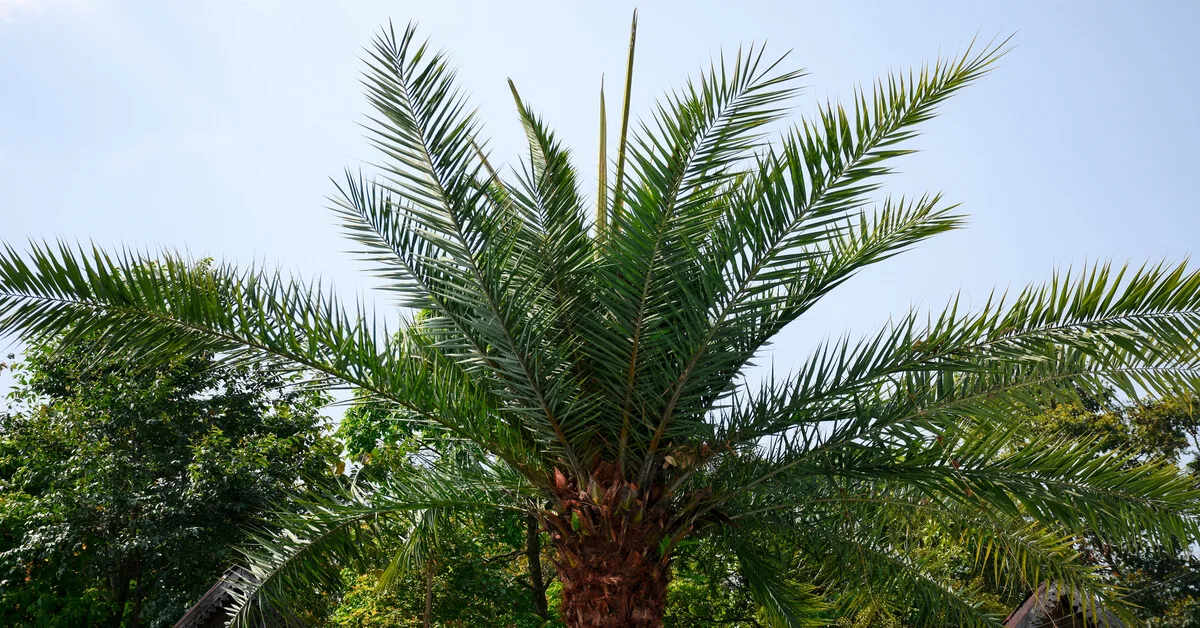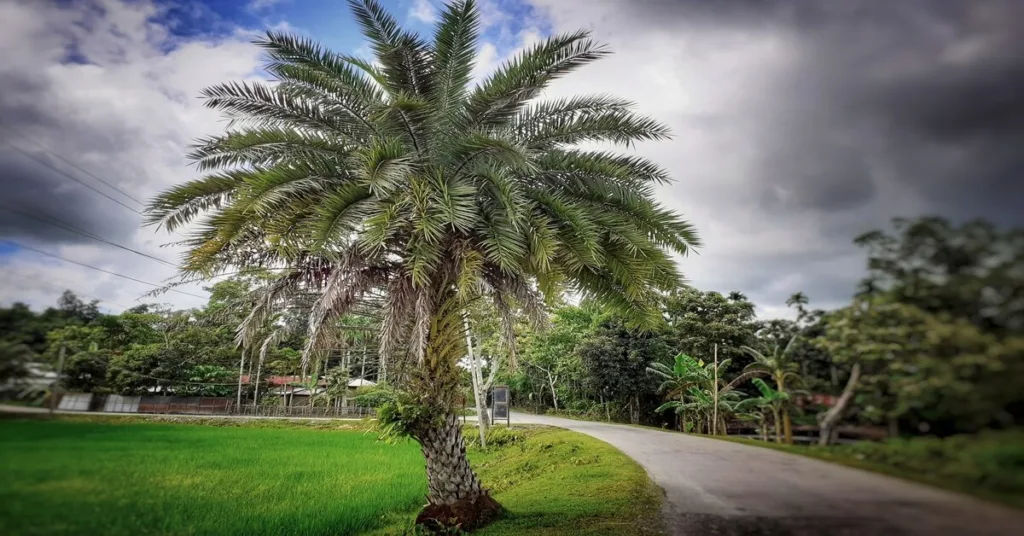Sylvester Palm Trees, scientific name Phoenix sylvestris, are date palms native to India. These tall, majestic trees have been grown in gardens and landscapes for centuries. That’s in part because growing sylvester palm trees is relatively simple. With the right care and maintenance, these wild date palms will reach heights up to 50′ to 60′ tall!
Did you also know that the sylvester palm goes by other names? Those other names include sugar date palm, silver date palm, wild date palm, and Indian date palm. It is quite the infamous plant!
To get the most out of your Sylvester palm tree, it’s important to understand the best care practices. By following our tips, you can grow a healthy sylvester palm tree that adds beauty to your garden for years to come!
Sylvester Palm Tree Care

Like pygmy date palms and other plants of the Phoenix genus, Sylvester trees are easy to grow. All they require is a moderate level of care that almost any new landscaper or gardener can master.
Despite needing only a moderate level of care, it’s still important to know the ins and outs of the plant’s needs. If you want to plant a Sylvester palm tree and have it thrive, follow these top general care practices!
Soil
A standard sandy loamy soil type is best for these wild date palms. Although, some gardeners and landscapers have also found standard sand suitable.
Watering
Sylvester palms need to water once a week to remain hydrated. But when establishing the plant from seed and transplant, it’s best to water it two to three times per week for a month. If you struggle to remember to water your plants, consider setting an alarm on your phone as a reminder.
Lighting
Sylvester palm or silver date palm trees thrive in sunlight. So, if you plan to grow this gorgeous palm, choose an area of your property that receives eight hours of light a day.
Humidity & Temperature
This palm is hardy and cold-tolerant and can withstand evening temperatures as low as 15°F or -9.4°C. On average, sylvester palms thrive where evening temperatures don’t dip below 20°F to 40°F or -6.67°C to 4.4°C. It is also best to grow the plant with high relative humidity considering it thrives in USDA zones nine through eleven [1].
Fertilizing
Slow-release liquid palm fertilizers applied every six to eight weeks in the spring, summer, and fall, work wonders for this tree. That is because palm fertilizer doesn’t just have the right ratio of NPK; it also has the added amount of magnesium necessary for the tree to flourish.
Pruning
It is best to prune this phoenix palm in the late spring to early summer, think May through June. The reason you want to prune this tree is to remove yellowing leaves and promote healthy growth. To prune a Phoenix sylvestris, take a pair of pruners and remove decaying fronds 2.5cm from their base.
Propagation
Wild date palms have offshoots that grow at the base of their trunks. Those are perfect for propagation because they are exact clones of the parent plant.
To propagate a wild date palm, all you have to do is separate an off-shoot with roots attached. After, find the location where you would like to grow the new tree and place the cutting there with sandy loam soil. Once planted in place, water every two to three days for a month to establish the tree.
Diseases & Pests
Lethal Bronzing Disease, caused by phytoplasma bacteria, significantly impacts wild date palm trees. Once infected, the tree will rapidly decline in health. Per the name, the leaves will turn from their standard lush green to a decaying bronze. The trees can become infected when the pest, Haplaxius crudus, sucks sap from the tree. The disease was originally found in Phoenix palms located in Texas. It had such a profound effect on the plant in the area that the disease was formerly named Texas Phoenix Palm Decline [2].
As stated before, Haplaxius crudus (American palm cixiid) can harm this tree. General landscaping and plant care are best for keeping the pest at bay.
Toxicity
The thorns found on the bases of wild date palm trees are not only sharp but toxic too. It is best to keep small children away from the plant.
How to Plant & Grow Sylvester Palms
Okay, so now you know about general sylvester palm care, but how do you plant and grow the palm from seeds? If you are unsure about how to start the sylvester palm tree growing process, look no further, GIY Plants is here to help!
When to Plant
To grow sylvester palm seeds, start the seeds indoors six to eight weeks before spring. That will give them enough time to sprout and be ready for transplant. As you can see, the sylvester palm growth rate can be slow to moderate. Typically, you will see 1″ to 1.5″ of growth each year.
It’s time to transplant your sprouted palm seeds after the six to eight-week period. The general ambient evening temperature should be at least 20°F or -6.67°C once it is time to transplant.
Where to Plant
When it’s time to transplant, place your sprouted seeds in a sunny location in a sandy loamy soil. It’s also important to note that this palm flourishes in zones nine through eleven.
How to Plant
Now, it’s time to learn how to plant! To start, gather a seed starting container and fill it with sandy loamy soil. After, place the seeds slightly below the soil surface and water. You will then want to place the container over a germination pad at 70°F or 21.1°C.
Once sprouted, you can transplant the growing palm seeds into their final location. After you choose your sunny spot with sandy loamy soil, place the sprouted seeds in the soil. The sprouts should still be exposed but the original seed/roots covered. Now, you can water and care for the plant as usual. In around 50 years, it should reach its full height of 50′ to 60′.
Sylvester Palm Fruit
The fruit of a sylvester palm plant is wild dates. These wild dates have a sweet taste and are not commonly found in grocery stores. They also have an oval shape and are typically 1″ in diameter.
Sylvester Palm vs Date Palm
The main difference between sylvester palms (Phoenix sylvestris) and date palms (Phoenix dactylifera) is cultivation. The sylvester palm or wild date palm produces edible dates but is not used in mass cultivation. Whereas the date palm produces Medjool dates and is used in mass cultivation.
Sylvester Palm Price
The price of an established sylvester palm tree, also known as silver date palm, can range from $70 to $185. If you want a lower-cost option, sylvester palm seeds only cost between $7 and $14 from online retailers.
References:
[1] Phoenix sylvestris – (L.)Roxb. Plants For A Future. (n.d.). Retrieved March 3, 2023, from https://pfaf.org/user/Plant.aspx?LatinName=Phoenix+sylvestris
[2] Bahder, B. W., & Helmick, E. E. (n.d.). LETHAL BRONZING DISEASE (LB). UF| IFAS Extension . Retrieved March 3, 2023, from https://edis.ifas.ufl.edu/publication/PP163


